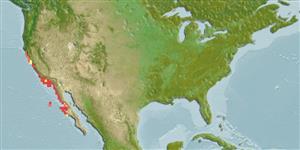>
Ovalentaria/misc (Various families in series Ovalentaria) >
Embiotocidae (Surfperches)
Etymology: Embiotoca: Greek, embios = permanent, for all the life + Greek, tokos,-oy = birth (Ref. 45335); jacksoni: jacksoni for A.C. Jackson , who first noted that black perch bore living young and brought this information to the attention of Alexander Agassiz (Ref. 4930).
More on author: Agassiz.
Environment: milieu / climate zone / depth range / distribution range
Ecologie
marien demersaal; diepte 0 - 46 m (Ref. 2850), usually ? - 6 m (Ref. 2850). Subtropical; 40°N - 23°N, 124°W - 114°W
Eastern Pacific: Fort Bragg in northern California, USA to central Baja California in Mexico, including Guadalupe Island (off northern central Baja California).
Grootte / Gewicht / Leeftijd
Maturity: Lm ? range ? - ? cm
Max length : 39.0 cm TL mannelijk / geslacht onbekend; (Ref. 2850); max. gepubliceerd gewicht: 700.00 g (Ref. 2850); max. gerapporteerde leeftijd: 10 Jaren (Ref. 56049)
Adults chiefly live in rocky areas near kelp, occasionally over sand bottom of coastal bays and around piers and pilings, and rarely in surf. Occur from intertidal areas to 46 m depth, but usually at about 6.1 m. Usually form small groups. Viviparous, female carries the developing young (Ref. 205).
Viviparous, female carries the developing young (Ref. 205).
Eschmeyer, W.N., E.S. Herald and H. Hammann, 1983. A field guide to Pacific coast fishes of North America. Boston (MA, USA): Houghton Mifflin Company. xii+336 p. (Ref. 2850)
Status op de Rode Lijst van het IUCN (Ref. 130435)
Gevaar voor de mens
Harmless
Gebruik door de mens
Visserij: commercieel
Tools
Speciale rapporten
Download XML
Internetbronnen
Estimates based on models
Preferred temperature (Ref.
123201): 12.8 - 19.3, mean 16.7 °C (based on 64 cells).
Fylogenetische diversiteitsindex (Ref.
82804): PD
50 = 0.7500 [Uniqueness, from 0.5 = low to 2.0 = high].
Bayesian length-weight: a=0.02951 (0.01493 - 0.05834), b=2.99 (2.81 - 3.17), in cm total length, based on LWR estimates for this species & (Sub)family-body (Ref.
93245).
Trofisch niveau (Ref.
69278): 3.3 ±0.38 se; based on food items.
Weerstandsvermogen (Ref.
120179): Gemiddeld, minimale populatieverdubbelingstijd 1,4-4,4 jaar (tm=1.5; tmax=10).
Fishing Vulnerability (Ref.
59153): Low to moderate vulnerability (29 of 100).
Nutrients (Ref.
124155): Calcium = 95.6 [52.9, 168.8] mg/100g; Iron = 1.15 [0.65, 1.96] mg/100g; Protein = 18.7 [17.7, 19.7] %; Omega3 = 0.264 [0.164, 0.428] g/100g; Selenium = 25.8 [13.2, 51.1] μg/100g; VitaminA = 6.99 [2.16, 22.97] μg/100g; Zinc = 0.694 [0.489, 1.013] mg/100g (wet weight);
